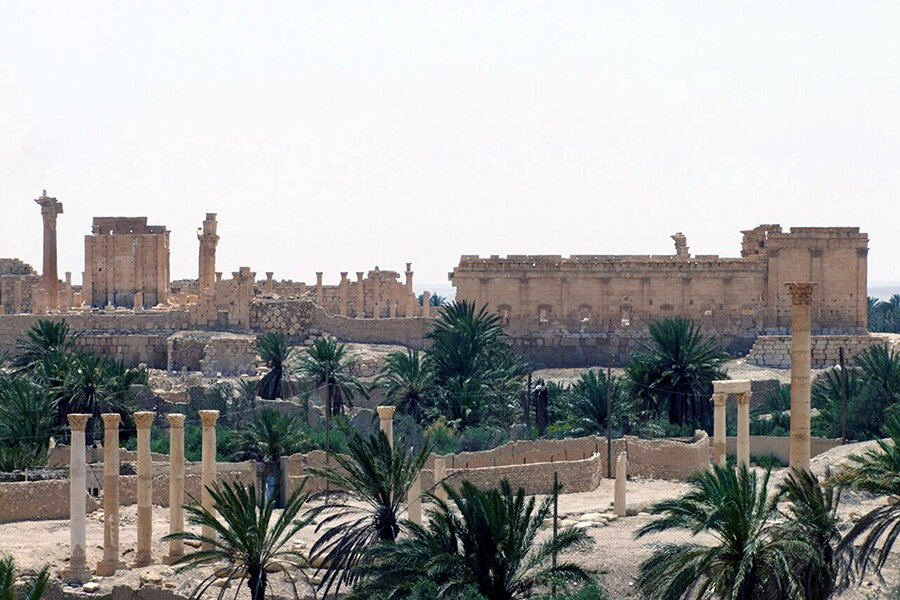Islamic State enters ancient Syrian city of Palmyra while residents flee
Loading...
| Beirut, Lebanon
Islamic State stormed the historic Syrian city of Palmyra on Wednesday, seizing parts of it from government forces in fierce fighting as civilians were evacuated and Syria's antiquities chief called on the world to save its ancient ruins.
If the Al Qaeda offshoot takes over Palmyra, it would be the first time it has captured a city directly from President Bashar al-Assad's forces, which have already lost ground in northwest and southern Syria to other insurgent groups in recent weeks.
The central city, also known as Tadmur, is built alongside the remains of a oasis civilization whose monumental colonnaded streets, temple and theater have stood for 2,000 years.
It is home to modern military installations, and sits on a desert highway linking the capital Damascus with Syria's eastern provinces, mostly under rebel control.
"Praise God, (Palmyra) has been liberated," said an Islamic State fighter speaking by internet from the area. He said Islamic State was in control of a hospital in the city which Syrian forces had used as a base before withdrawing.
Syrian state television said pro-government National Defense Forces (NDF) had evacuated civilians after large groups of Islamic State fighters entered the city.
"The news at the moment is very bad. There are small groups that managed to enter the city from certain points," Syria's antiquities chief Maamoun Abdulkarim told Reuters earlier on Wednesday. "There were very fierce clashes."
Abdulkarim, who won an award from the UN agency UNESCO last year for protecting cultural heritage, said hundreds of statues had been moved to safe locations but called on the Syrian army, opposition and international community to save the site.
"The fear is for the museum and the large monuments that cannot be moved," he said. "This is the entire world's battle."
UNESCO called for an immediate halt to the fighting and called for international efforts to protect the population "and safeguard the unique cultural heritage."
DESERT OASIS
Islamic State has destroyed antiquities and ancient monuments in neighboring Iraq and is being targeted by US-led air strikes in both countries.
The Britain-based Syrian Observatory for Human Rights monitoring group said that the group had captured around a third of Palmyra. State TV said there was heavy fighting in the northern part of the city and that NDF fighters were "confronting attempts by (Islamic State) fighters to infiltrate the rest of the city."
Palmyra's ancient monuments, which lie on the south-western fringe of the modern city, were put on UNESCO's World Heritage in danger list in 2013.
The ruins were part of a desert oasis that was one of the most significant cultural centers of the ancient world.
The attack is part of a westward advance by Islamic State that is adding to the pressures on Assad's overstretched military and allied militia.
A video posted by an activist network on YouTube appeared to show black smoke rising into the sky. The caption dated May 20 said it was footage of air strikes on the city. A communications tower and a citadel could be seen in the video.
Islamic State supporters posted pictures on social media showing what they said were gunmen in the streets of Palmyra, which is the location of one of Syria's biggest weapons depots as well as army bases, an airport and a major prison.
In Syria's northeast, Kurdish forces backed by US-led air strikes are pressing an attack on Islamic State that has killed at least 170 members of the jihadist group this week, a Kurdish official and the Observatory said. US-led forces have concentrated their air strikes on Syria's north and east, areas out of government control.
The official said Kurdish YPG fighters and allied militia had encircled Islamic State in a dozen villages near the town of Tel Tamr in Hasaka province, which borders land controlled by Islamic State in neighboring Iraq.
"The confirmed number of (Islamic State) dead is between 170 and 200," said Kurdish official Nasir Haj Mansour, speaking by telephone from Syria.







